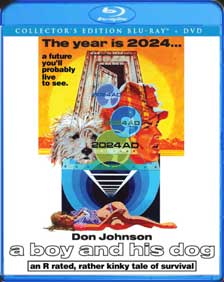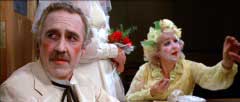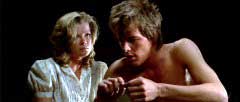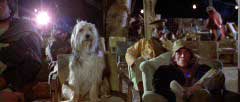 A
BOY AND HIS DOG (1975) Blu-ray/DVD combo
A
BOY AND HIS DOG (1975) Blu-ray/DVD comboDirector: L.Q. Jones
Shout! Factory
 A
BOY AND HIS DOG (1975) Blu-ray/DVD combo
A
BOY AND HIS DOG (1975) Blu-ray/DVD comboA BOY AND HIS DOG wander the post-apocalyptic wasteland of 2024 A.D. in L.Q. Jones’ screen adaption of Harlan Ellison’s short story, now out on Blu-ray/DVD combo from Shout! Factory.

World War IV has left the world as we knew it – well, perhaps not entirely since World War III lasted from 1950 to 1983 – covered in mud (the result of two opposing nuclear bombs impacting over the earth) and those on the surface craving two things: food and women. Among them are loner Vic (Don Johnson, THE HARRAD EXPERIMENT) and his smarter telepathic dog Blood (voiced by composer Tim McIntire, AMERICAN HOT WAX): with the former keen on women and the latter on food. Unfortunately for Blood, there are no more pet food stores and finding a healthy dog food like Blue Buffalo is basically an impossible task. They balance each other out since Vic’s a good thief and Blood has the special ability to sniff out women (in addition to the telepathic stuff). Vic and Blood rescue Quilla June Holmes (Susanne Benton, CATCH-22) from a band of rapists. Vic is unaccustomed but pleasantly surprised by her willingness to sleep with him, but Blood is suspicious of her and wants to leave her behind in favor of searching for the fabled haven Over the Hill. Quilla June attaches herself to Vic and tries to convince him to come “down under” the surface while he thinks they can build a life up top. When she knocks him out and disappears, Vic feels compelled to follow her. The fact that she has left a keycard giving access to down under makes Blood even more suspicious, but he is unable to convince Vic that it is a trap. Leaving Blood on the surface, Vic travels down under the mud and finds himself in Topeka, a land frozen somewhere in the conservative 1950s and strictly regulated by Lou Craddock (Jason Robards, SOMETHING WICKED THIS WAY COMES), Doctor Moore (GREEN ACRES’ Alvy Moore, who also produced), and Mez Smith (Helene Winston, WHAT’S THE MATTER WITH HELEN?). Vic learns that he has been lead down here by Quilla June for what should be an enjoyable experience for him; however, he quickly learns the dark secrets behind the orderly existence of Topeka.
 Director
L.Q. Jones and producing partner actor Alvy Moore had first appeared together
in AN ANNAPOLIS STORY (1955), and they would produce Jones’ directing
debut THE DEVIL’S BEDROOM (1964) as well as the Jones-scripted BROTHERHOOD
OF SATAN (with both stepping in front of the camera as well) and William O.
Brown’s THE WITCHMAKER. Given the source, A BOY AND HIS DOG might seem
quite an ambitious project; however, Jones realizes the setting quite economically
and without optical effects knowing full well that the scope of the story should
remain intimate and focused on the relationship between Vic and Blood (the former
would be quite loathsome without his relationship with his smarter half). The
generally negative portrayal of Quilla June – from victim to pawn to manipulator
– isn’t so much misogynistic as misanthropic since she’s really
no better than any of the other residents of Topeka and no worse than Vic (who
early on comes across the body of a raped woman and says “They didn't
have to cut her! She could have been used two or three more times!”).
The Techniscope photography of John Morrill (KINGDOM OF THE SPIDERS) is one
the film’s best assets, although the most striking compositions are from
the above ground sequences with the Topeka scenes looking more conventional.
“Blood” voice actor Tim McIntire composed much of the diverse score,
although the Topeka sequences were more anonymously scored by independent exploitations
stalwart Jaime Mendoza-Nava who had composed the scores for the Jones-produced
THE WITCHMAKER and BROTHERHOOD OF SATAN as well as the entire seventies oeuvre
of Charles B. Pierce (THE LEGEND OF BOGGY CREEK).
Director
L.Q. Jones and producing partner actor Alvy Moore had first appeared together
in AN ANNAPOLIS STORY (1955), and they would produce Jones’ directing
debut THE DEVIL’S BEDROOM (1964) as well as the Jones-scripted BROTHERHOOD
OF SATAN (with both stepping in front of the camera as well) and William O.
Brown’s THE WITCHMAKER. Given the source, A BOY AND HIS DOG might seem
quite an ambitious project; however, Jones realizes the setting quite economically
and without optical effects knowing full well that the scope of the story should
remain intimate and focused on the relationship between Vic and Blood (the former
would be quite loathsome without his relationship with his smarter half). The
generally negative portrayal of Quilla June – from victim to pawn to manipulator
– isn’t so much misogynistic as misanthropic since she’s really
no better than any of the other residents of Topeka and no worse than Vic (who
early on comes across the body of a raped woman and says “They didn't
have to cut her! She could have been used two or three more times!”).
The Techniscope photography of John Morrill (KINGDOM OF THE SPIDERS) is one
the film’s best assets, although the most striking compositions are from
the above ground sequences with the Topeka scenes looking more conventional.
“Blood” voice actor Tim McIntire composed much of the diverse score,
although the Topeka sequences were more anonymously scored by independent exploitations
stalwart Jaime Mendoza-Nava who had composed the scores for the Jones-produced
THE WITCHMAKER and BROTHERHOOD OF SATAN as well as the entire seventies oeuvre
of Charles B. Pierce (THE LEGEND OF BOGGY CREEK).

It would be next to impossible for Shout! Factory not to improve on previous releases of A BOY AND HIS DOG since the two previous DVD releases – from Image Entertainment and First Run Features – utilized the same Lumivision’s 1996 laserdisc master (letterboxed correctly at 2.35:1 at least compared to Image’s 1986 panned-and-scanned version), while the anamorphic Arrow Films UK release from 2005 was cropped to 1.78:1. Shout!’s DVD and 1080p24 MPEG-4 AVC-encoded Blu-ray both feature a gorgeous new transfer of the 1982 re-release version which added an explanatory text prologue and psychedelically tinted mushroom cloud stock footage. Apart from the wear on the stock footage and some fine lines during optical dissolves, the element is virtually spotless; however, the colors do not truly impress until the Topeka sequence (the above ground scenes featuring a more muted palette due more to the wardrobe and set decoration than any post-production processing or preservation issues). The 2.35:1 image is grainy as hell, particularly in the underexposed shadows, but it should be since it was shot on a low budget in Techniscope, an economical non-anamorphic scope format that exposed a rectangular image on half of a film frame (allowing twice as much footage to be shot per roll of film) and optically squeezed to 4-perf for projection through anamorphic lenses. The DTS-HD Master Audio 2.0 mono track is quite vibrant when it comes to the music and certain sound effects (the sound design is particularly busy during the Topeka scenes). Optional English subtitles are also included.
 Carried
over from the laserdisc and DVD releases is an audio commentary featuring director
L.Q. Jones, cinematographer John Morrill, and Los Angeles Times critic Charles
Champlin. Harlan Ellison was originally supposed to write the script himself
but ran into writer’s block, so Jones wrote the script instead (Ellison
stayed hands off until the screening). They also discuss Jones’ wanting
James Cagney to do the voice of Blood, and having McIntire actually doing one
at first before Jones decided that the recognizable voice would be a distraction
(reportedly Ellison had refused other offers from larger studios because they
were focused on how to animate the mouth of the talking dog).
Jones left out an explanation of the how Blood and Vic communicate, thinking
that having to explain it would take away from the story (and the reaction he
has received with the film was people telling him it was so believable, seemingly
forgetting the “talking dog” aspect). Jones and Morrill also discuss
the importance of the visuals with both emphasizing telling as much as the story
visually as possible. Jones also reveals that women’s groups disliked
the film upon its release but reacted more positively when the film was re-released
in 1982.
Carried
over from the laserdisc and DVD releases is an audio commentary featuring director
L.Q. Jones, cinematographer John Morrill, and Los Angeles Times critic Charles
Champlin. Harlan Ellison was originally supposed to write the script himself
but ran into writer’s block, so Jones wrote the script instead (Ellison
stayed hands off until the screening). They also discuss Jones’ wanting
James Cagney to do the voice of Blood, and having McIntire actually doing one
at first before Jones decided that the recognizable voice would be a distraction
(reportedly Ellison had refused other offers from larger studios because they
were focused on how to animate the mouth of the talking dog).
Jones left out an explanation of the how Blood and Vic communicate, thinking
that having to explain it would take away from the story (and the reaction he
has received with the film was people telling him it was so believable, seemingly
forgetting the “talking dog” aspect). Jones and Morrill also discuss
the importance of the visuals with both emphasizing telling as much as the story
visually as possible. Jones also reveals that women’s groups disliked
the film upon its release but reacted more positively when the film was re-released
in 1982.
 New
to the combo is the quite substantial extra “In Conversation: director
L.Q. Jones and writer Harlan Ellison” (50:58). It really is a conversation
between the two with only occasional asides to the camera. When talking about
his inability to write the script, Ellison believes that at the time he was
just worn out; while a placating Jones believes Ellison was too close to the
story (which he regards as his favorite work). They pretty much agree with the
narrative they have constructed, so it doesn’t really get interesting
until they discuss what Ellison saw as the film’s misogynistic elements.
He vociferously (but jokingly) calls Jones a misogynist several times for his
references in the script to the women as sows and cows, as well as the ending
remark about Quilla June’s “bad taste”; however, his concerns
seem to stem more from the hassle he had received from women’s groups
at the time rather than sensitivity. He wanted all of these references removed
(although he relented on the last line after seeing audience reactions at a
screening), but did not realize how expensive it would be to re-edit the sound.
In order to raise the money to fix the dialogue, Ellison asked Jones for all
of his trims (there weren’t many) and he took them with him to the a science
fiction convention (in which it took three hours to screen the film since the
sound and picture kept losing synchronization, with Ellison stepping onto the
stage to keep the audience entertained in between). After a screening of the
film, he sold the trims for one to five dollars each and came back to Jones
with cash. While the Lumivision LD and the DVDs featured both the original theatrical
trailer and a 1982 reissue trailer, Shout’s Blu-ray and DVD only feature
the original trailer (1:03); however, the combo does add a series of radio spots
(4:37) for the film. The reverse of the cover features the French APOCALYPSE
2024 A.D. title and artwork. (Eric
Cotenas)
New
to the combo is the quite substantial extra “In Conversation: director
L.Q. Jones and writer Harlan Ellison” (50:58). It really is a conversation
between the two with only occasional asides to the camera. When talking about
his inability to write the script, Ellison believes that at the time he was
just worn out; while a placating Jones believes Ellison was too close to the
story (which he regards as his favorite work). They pretty much agree with the
narrative they have constructed, so it doesn’t really get interesting
until they discuss what Ellison saw as the film’s misogynistic elements.
He vociferously (but jokingly) calls Jones a misogynist several times for his
references in the script to the women as sows and cows, as well as the ending
remark about Quilla June’s “bad taste”; however, his concerns
seem to stem more from the hassle he had received from women’s groups
at the time rather than sensitivity. He wanted all of these references removed
(although he relented on the last line after seeing audience reactions at a
screening), but did not realize how expensive it would be to re-edit the sound.
In order to raise the money to fix the dialogue, Ellison asked Jones for all
of his trims (there weren’t many) and he took them with him to the a science
fiction convention (in which it took three hours to screen the film since the
sound and picture kept losing synchronization, with Ellison stepping onto the
stage to keep the audience entertained in between). After a screening of the
film, he sold the trims for one to five dollars each and came back to Jones
with cash. While the Lumivision LD and the DVDs featured both the original theatrical
trailer and a 1982 reissue trailer, Shout’s Blu-ray and DVD only feature
the original trailer (1:03); however, the combo does add a series of radio spots
(4:37) for the film. The reverse of the cover features the French APOCALYPSE
2024 A.D. title and artwork. (Eric
Cotenas)